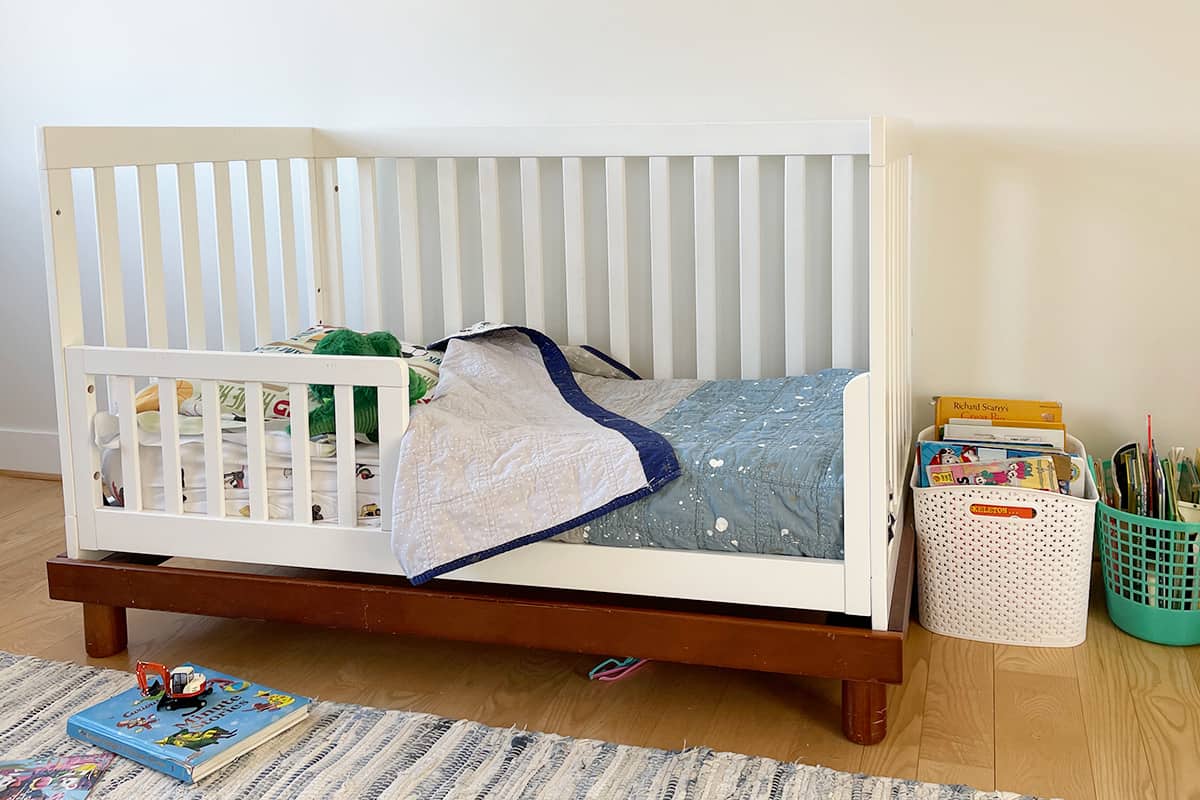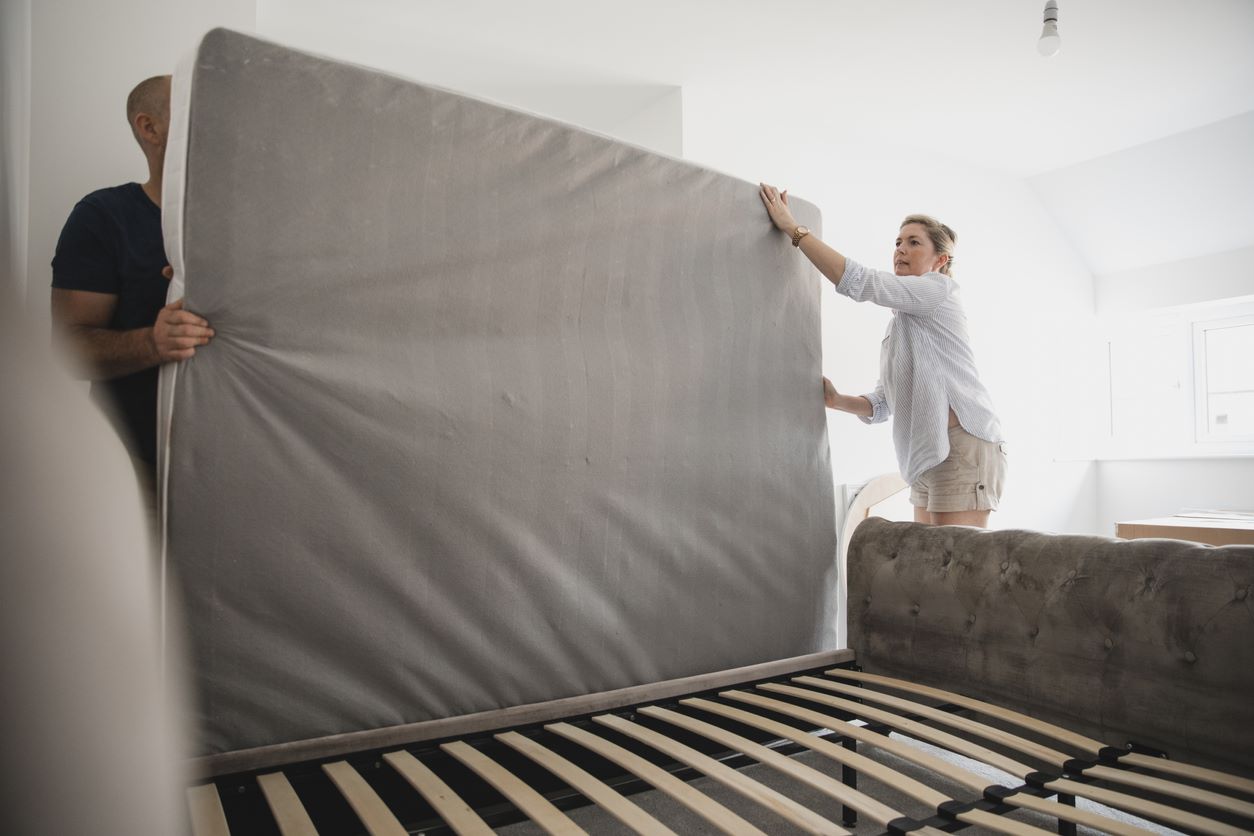Home>Furniture>Bedroom Furniture>How To Get A Toddler To Sleep In Their Own Bed


Bedroom Furniture
How To Get A Toddler To Sleep In Their Own Bed
Modified: January 19, 2024
Discover effective tips and tricks for getting your toddler to sleep comfortably in their own bed with our wide range of bedroom furniture.
(Many of the links in this article redirect to a specific reviewed product. Your purchase of these products through affiliate links helps to generate commission for Storables.com, at no extra cost. Learn more)
Introduction
Welcome to the world of parenthood, where the sweet moments are plentiful, and the challenges can sometimes leave you feeling sleep-deprived and overwhelmed. One of the biggest challenges many parents face is trying to get their toddler to sleep in their own bed. While it may seem like an impossible task at times, with the right strategies and a little bit of patience, you can help your little one make the transition to sleeping in their own bed a more peaceful and successful one.
As toddlers grow and develop, their sleep needs change, and they begin to assert their independence. This newfound independence often translates into a desire to sleep in their own bed. However, for many toddlers, the thought of sleeping alone can be scary or uncomfortable. They may feel separation anxiety or have fears of monsters under the bed. It’s essential to understand and address these concerns with compassion and patience.
In this article, we will provide you with some practical tips and strategies to help you get your toddler to sleep in their own bed. From establishing a bedtime routine to creating a comfortable sleep environment, we will explore various approaches that can make the transition smoother for both you and your child.
So, get ready to bid farewell to those sleepless nights and give your toddler the tools they need to sleep soundly in their own bed.
Key Takeaways:
- Establishing a consistent bedtime routine and creating a comfortable sleep environment are key to helping toddlers transition to sleeping in their own bed. Encourage independence and address fears with patience and understanding for a successful transition.
- Positive reinforcement, addressing separation anxiety, and validating nighttime fears are essential in helping toddlers feel secure and confident in their own bed. Approach challenges with patience, empathy, and creative problem-solving for a peaceful bedtime routine.
Read more: How To Keep A Toddler In Bed
Creating a Bedtime Routine
One of the most effective ways to help your toddler sleep in their own bed is by establishing a consistent bedtime routine. Routines provide structure and predictability, helping your child feel secure and prepared for sleep. Here are some steps to create a bedtime routine:
- Set a Consistent Bedtime: Choose a suitable bedtime that allows your toddler to get the recommended amount of sleep for their age. Consistency is key, so try to stick to the same bedtime every night, even on weekends.
- Start Winding Down: Begin the bedtime routine about 30 minutes before your toddler’s intended bedtime. This allows them to transition from their daytime activities to a more relaxed state. Activities such as reading a book, taking a bath, or listening to soft music can help signal that it’s time to wind down.
- Create a Calm Environment: Make your child’s bedroom a soothing and comfortable space. Dim the lights, use a nightlight if necessary, and play soft, gentle music to create a serene atmosphere.
- Limit Screen Time: Avoid electronic devices, such as tablets or smartphones, in the hour leading up to bedtime. The blue light emitted by screens can interfere with melatonin production, making it harder for your child to fall asleep.
- Establish a Bedtime Ritual: Incorporate activities that your toddler enjoys and finds relaxing. This could be singing a lullaby, cuddling, or talking about their day. Consistency is key, so perform these rituals in the same order every night.
- Stick to a Regular Sleep Schedule: In addition to a consistent bedtime, it’s important to have regular wake-up times. This helps regulate your child’s body clock and makes it easier for them to fall asleep at night.
Remember, the goal of a bedtime routine is to create a calm and predictable atmosphere that signals to your toddler that it’s time to sleep. By following these steps and adapting the routine to your child’s preferences, you’ll help set the stage for a peaceful transition to their own bed.
Setting up a Comfortable Sleeping Environment
Creating a comfortable sleeping environment for your toddler is crucial in helping them feel secure and at ease in their own bed. Here are some tips to set up a cozy sleep space:
- Choose the Right Bed: Select a bed that is appropriate for your toddler’s age and size. Whether it’s a toddler bed, a twin bed, or a mattress on the floor, ensure that it is comfortable and safe.
- Invest in Quality Bedding: Opt for soft and breathable bedding materials, such as cotton or bamboo. Provide your child with a comfortable mattress, cozy blankets, and a supportive pillow if they are old enough.
- Create a Sleep-Friendly Atmosphere: Keep the bedroom cool, dark, and quiet. Use blackout curtains to block out any external light, and consider using a white noise machine or soft music to drown out any disruptive noises.
- Eliminate Distractions: Remove any toys or stimulating items from your child’s bed that might tempt them to play instead of sleep. Keep the bedroom clutter-free and create a designated play area in another part of the house.
- Address Safety Concerns: Ensure that the sleeping environment is safe for your toddler. Use bed rails if needed to prevent falls, secure furniture to the wall to avoid accidents, and check for any choking hazards.
- Personalize the Space: Let your toddler have some input in decorating their bedroom. Allow them to choose their bedding, pick out a stuffed animal to sleep with, or hang up some of their artwork. Creating a space that feels personal and comforting can make the transition to their own bed more enjoyable.
Remember, a comforting and inviting sleep environment plays a significant role in helping your toddler feel safe and relaxed in their own bed. By paying attention to these details, you can create a sleep haven that encourages restful sleep and a positive association with their bed.
Establishing Boundaries and Consistency
When it comes to getting your toddler to sleep in their own bed, establishing boundaries and consistency is key. Clear expectations and consistent routines can help your child feel secure and understand what is expected of them. Here are some strategies to help you establish boundaries and maintain consistency:
- Set Bedtime Rules: Clearly communicate the bedtime rules to your toddler. For example, let them know that they are expected to sleep in their own bed throughout the night. Be firm but gentle when enforcing these rules.
- Use Positive Reinforcement: Praise and reward your child for their efforts in sleeping in their own bed. This can be done through verbal praise, a sticker chart, or a small reward system. Positive reinforcement can motivate your child to continue sleeping in their own bed.
- Be Consistent with Consequences: If your toddler consistently tries to leave their bed, calmly and firmly guide them back without engaging in lengthy discussions or negotiations. Consistency in enforcing consequences will help reinforce the bedtime rules and expectations.
- Avoid Giving In: It can be tempting to give in to your toddler’s requests to sleep with you or allow them to join you in your bed. However, giving in can undermine the boundaries you have set and make it more challenging for your child to adjust to sleeping in their own bed.
- Encourage Self-Soothing: Help your toddler develop self-soothing skills by gradually reducing your presence in their bedroom at bedtime. Start by staying in the room until they fall asleep, then gradually move towards sitting outside their room or checking in at longer intervals. This gradual process allows your child to become more independent in soothing themselves to sleep.
- Communicate and Validate: Talk to your toddler about their feelings and concerns regarding sleeping in their own bed. Validate their emotions and reassure them that it’s normal to feel a little scared or uncomfortable at first. Let them know that you are there to support and help them through the transition.
Remember, it may take time for your toddler to adjust and feel comfortable sleeping in their own bed. Consistency, patience, and clear boundaries will help your child understand the expectations and create a sense of security. With time, they will become more confident and independent in their sleep habits.
Using Positive Reinforcement
Positive reinforcement is a powerful tool when it comes to encouraging your toddler to sleep in their own bed. By rewarding and praising their efforts, you can motivate and reinforce the desired behavior. Here are some strategies to effectively use positive reinforcement:
- Create a Reward System: Develop a simple reward system to celebrate your child’s successful nights of sleeping in their own bed. This could be a sticker chart, where they earn a sticker for each night they stay in their bed. After accumulating a certain number of stickers, they can receive a small prize or privilege.
- Offer Verbal Praise: Give your toddler plenty of verbal praise and encouragement when they sleep in their own bed. Let them know how proud you are of them for being independent and remind them of the positive aspects of sleeping in their own bed, such as feeling cozy and secure.
- Provide Special Bedtime Treats: Create special bedtime treats that your child can only enjoy if they stay in their own bed. It could be a small bedtime snack they love or a special bedtime story that is reserved for nights when they successfully sleep in their bed.
- Plan Fun Morning Activities: Encourage your toddler to stay in their own bed by planning fun activities for the morning. Let them know that if they sleep in their bed, they’ll get to participate in enjoyable morning activities like making pancakes, going to the park, or having extra playtime.
- Involve Your Child in Decision-Making: Engage your child in the process of creating rewards and incentives. Let them have some input in choosing the rewards and involve them in tracking their progress. This sense of ownership can increase their motivation to sleep in their own bed.
- Be Specific with Praise: When praising your child for sleeping in their own bed, be specific and acknowledge their effort. Instead of saying, “Good job!” say something like, “You did a fantastic job staying in your bed all night! I’m so proud of you for being a big kid and sleeping independently.”
Remember, positive reinforcement is about acknowledging and celebrating your child’s success in sleeping in their own bed. By using rewards, praise, and exciting morning activities, you can make the experience more enjoyable and encourage your toddler to continue the positive behavior.
Create a consistent bedtime routine to signal it’s time for sleep. This could include a bath, story time, and cuddles. Stick to the routine every night to help your toddler feel secure and ready for bed in their own room.
Read more: What Size Is A Toddler Bed
Dealing with Separation Anxiety
Separation anxiety is a common issue that many toddlers experience when trying to sleep in their own bed. The fear of being separated from their caregivers can make it challenging for them to feel comfortable sleeping alone. Here are some strategies to help your toddler cope with separation anxiety:
- Gradual Transition: Start by gradually transitioning your child to their own bed. Begin with naps or the first part of the night and gradually increase the duration they spend in their own bed. This allows them to adjust to the change in a more manageable way.
- Establish a Reassuring Bedtime Routine: Create a bedtime routine that includes activities that your child finds comforting and reassuring. This could include reading a favorite story, cuddling, or singing a lullaby. These familiar activities can help your toddler feel secure and ease their separation anxiety.
- Provide Comfort Objects: Encourage your child to sleep with a special comfort object, such as a stuffed animal or a blanket. These items can provide a sense of security and help alleviate separation anxiety.
- Implement a Transitional Object: Consider using a transitional object that carries the scent of the caregiver, such as a small cloth or a shirt. This can help soothe your toddler and provide a connection to you even when you are not physically present.
- Stay with Them Until They Fall Asleep: In the beginning, stay with your child until they fall asleep. This can provide them with a sense of security and gradually decrease their anxiety about sleeping alone. Gradually reduce the amount of time you stay with them, sitting farther away from their bed each night.
- Reassure and Validate Their Feelings: Talk to your child about their fears and validate their emotions. Reassure them that it’s okay to feel scared or anxious and that you understand their feelings. Provide comforting words and physical reassurance as needed.
- Practice Separation During the Day: Help your child get used to brief periods of separation during the day. Encourage them to play independently in another room while you are nearby. Gradually increase the duration of separation to build their confidence in being away from you.
- Establish a Communication Strategy: If your child is old enough, talk about how they can communicate with you if they need reassurance during the night. This can be through a baby monitor, a special signal, or a designated time to check in with you.
Remember, separation anxiety is a normal part of a child’s development, and it can take time for them to feel comfortable sleeping in their own bed. By implementing these strategies and providing reassurance, you can help your toddler navigate through their separation anxiety and gradually become more confident in sleeping independently.
Addressing Nighttime Fears or Monsters
Nighttime fears and imaginary monsters are common reasons why toddlers may resist sleeping in their own bed. These fears can make bedtime a stressful experience for both children and parents. Here are some ways to address and alleviate nighttime fears:
- Listen and Validate: Take the time to listen to your child’s fears and validate their feelings. Let them know that it’s normal to feel scared sometimes and that you understand their concerns. Reassure them that you are there to keep them safe.
- Be Empathetic: Show empathy towards your child’s fears and provide comfort. Offer words of reassurance and understanding. For example, you can say, “I know monsters can seem scary, but they are not real. You are safe in your bed, and I am here to protect you.”
- Encourage Imagination Control: Teach your child to take control of their imagination. Help them imagine something positive or create a special “protector” object in their mind, such as a superhero or a magical shield, that will keep away any scary thoughts or monsters.
- Use Nightlights or Dim Lighting: Provide a comforting and soothing environment by using a nightlight or dimming the lights in your child’s bedroom. This can help alleviate fears of the dark and create a sense of security.
- Show the Empty Closet and Under the Bed: Help your child overcome their fears by showing them that the closet and under the bed are empty and safe. Talk about how these spaces are just like any other part of the room and emphasize their safety.
- Implement a Monster Spray Routine: Create a fun and playful routine where you “spray away” monsters with a pretend monster spray. Use a spray bottle filled with water or a mixture of water and essential oils, and spray it around the room before bedtime to create a monster-free environment.
- Provide a Sense of Security: Offer your child a comfort object, such as a favorite stuffed animal or a special blanket, to sleep with. Having something familiar and comforting can provide a sense of security and help alleviate fears.
- Read Books About Overcoming Fears: Choose age-appropriate books that address nighttime fears and monsters. Reading these books together can help your child understand that fears are common and provide strategies for coping with them.
Remember, it’s important to be patient and compassionate when addressing your child’s nighttime fears. By actively listening, providing reassurance, and implementing creative techniques, you can help your toddler overcome their fears and feel more at ease when sleeping in their own bed.
Encouraging Independence
Encouraging independence is an essential aspect of helping your toddler sleep in their own bed. By empowering them to take ownership of their sleep routine, you can instill a sense of confidence and self-reliance. Here are some strategies to encourage independence:
- Involve Your Toddler in the Decision: Explain to your child why it’s important for them to sleep in their own bed and involve them in the decision-making process. When they feel like they have a say in the matter, they are more likely to embrace the idea.
- Give Them Choices: Offer your child choices when it comes to their bedtime routine. For example, let them choose which pajamas to wear, which stuffed animal to sleep with, or which book to read before bed. This gives them a sense of control and ownership over their sleep experience.
- Encourage Self-Help Skills: Teach your child how to do things independently, such as putting on their own pajamas, brushing their teeth, or turning off the lights. These small acts of independence can empower them and make them feel more capable at bedtime.
- Create a Bedtime Checklist: Make a visual or written checklist that your child can follow to complete their bedtime routine. This provides them with a sense of accomplishment as they check off each item on the list, and it helps them develop a sense of responsibility.
- Transition Gradually: If your child is hesitant to sleep in their own bed, introduce the transition gradually. Start by having them sleep in their own bed for a part of the night and gradually increase the duration over time. This helps ease them into the new routine without overwhelming them.
- Celebrate Achievements: Offer praise and celebrate your child’s milestones and achievements in sleeping in their own bed. Let them know how proud you are of their progress and highlight the positive aspects of being independent and self-sufficient.
- Support Self-Soothing Techniques: Encourage your child to develop self-soothing techniques, such as deep breathing or counting, to help them fall asleep independently. Teach them these techniques and provide gentle reminders when needed.
- Be Patient and Consistent: It may take time for your child to fully embrace sleeping in their own bed. Be patient and consistent in reinforcing the importance of independence and continue to support them along the way.
Remember, every child is different, and the time it takes for them to feel comfortable sleeping in their own bed may vary. By incorporating these strategies and fostering a sense of independence, you can help your toddler develop important life skills while enjoying a more peaceful bedtime routine.
Dealing with Resistance and Difficulties
When it comes to getting your toddler to sleep in their own bed, you may encounter resistance and difficulties along the way. It’s important to approach these challenges with patience, understanding, and a flexible mindset. Here are some tips to help you navigate through resistance and difficulties:
- Validate Their Feelings: Acknowledge and validate your child’s feelings of resistance or difficulty. Let them know that it’s okay to feel unsure or scared about sleeping in their own bed and that you are there to support them.
- Address the Underlying Issue: Take the time to understand the root cause of your child’s resistance. Are they experiencing separation anxiety, having nighttime fears, or struggling with a change in routine? By addressing the underlying issue, you can better support them in overcoming their difficulties.
- Adjust Expectations: Be realistic in your expectations and understand that the transition to sleeping in their own bed may not happen overnight. It takes time for some children to feel comfortable and adjust to the new routine. Be patient and supportive throughout the process.
- Problem-Solve Together: Involve your child in problem-solving. If they express difficulties or concerns about sleeping in their own bed, brainstorm together for possible solutions. Encourage their input and guide them towards finding strategies that work for both of you.
- Offer Reassurance: Provide constant reassurance to your child that they are safe and loved. Remind them of the positive aspects of sleeping in their own bed, such as feeling cozy or having their own space, and reassure them that you are nearby if they need you.
- Implement a Gradual Transition: If your child is resistant to sleeping in their own bed, introduce the transition gradually. Start by spending a portion of the night in their room, such as through co-sleeping, then gradually decrease your presence over time. This can help build their confidence and comfort.
- Seek Support from a Professional: If your child’s resistance or difficulties persist, consider seeking guidance from a pediatrician, child psychologist, or sleep specialist. They can provide additional insights and strategies for addressing the challenges you face.
- Stay Consistent: Consistency is key when it comes to establishing new routines and overcoming resistance. Stick to the bedtime routine, reinforce the boundaries you have set, and remain consistent in your approach. This provides a sense of stability and helps your child adjust more effectively.
Remember, each child is unique, and it’s normal to face resistance and difficulties during the transition to sleeping in their own bed. By approaching these challenges with patience, empathy, and creative problem-solving, you can navigate through these obstacles and support your child in developing healthy sleep habits.
Read more: When To Transition To A Toddler Bed
Conclusion
Helping your toddler sleep in their own bed can be a journey filled with challenges, but with patience, understanding, and the right strategies, it is achievable. By creating a bedtime routine, setting up a comfortable sleeping environment, and establishing boundaries and consistency, you can lay the foundation for a successful transition. Using positive reinforcement, addressing separation anxiety, dealing with nighttime fears, and encouraging independence are additional tools in your toolbox.
Remember, each child is unique, and the process may take time. It’s crucial to approach the transition with empathy, validating their feelings, and offering reassurance along the way. Be patient and adjust your expectations, understanding that setbacks and difficulties may occur. Seek professional support if needed, and stay consistent in your approach.
The rewards of helping your toddler sleep in their own bed are worth the effort. They will develop important life skills such as independence, self-soothing, and problem-solving. Moreover, it creates a sense of security and confidence for them and a peaceful atmosphere for the entire family.
So, embrace the journey and remember that you are guiding your toddler towards healthy sleep habits that will benefit them for years to come. With your love, support, and persistence, you can help your little one sleep soundly and peacefully in their own bed.
Frequently Asked Questions about How To Get A Toddler To Sleep In Their Own Bed
Was this page helpful?
At Storables.com, we guarantee accurate and reliable information. Our content, validated by Expert Board Contributors, is crafted following stringent Editorial Policies. We're committed to providing you with well-researched, expert-backed insights for all your informational needs.













